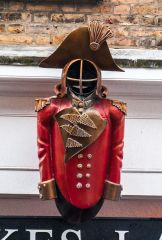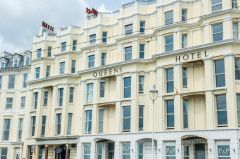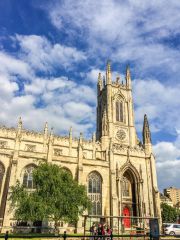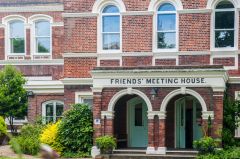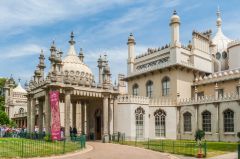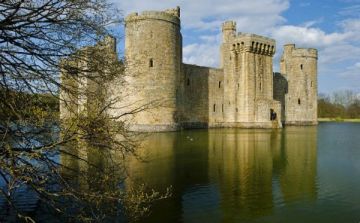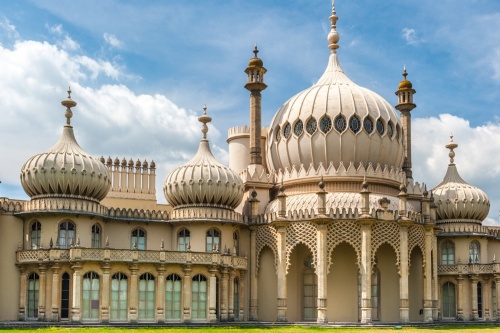
In 1750 a physician named Richard Russell published a book extolling the virtues of "oceanic fluid" (seawater to you and me) as a cure for hundreds of common ailments. Russell, a native of Lewes, Sussex, advocated not just bathing in seawater but drinking it as well. Russell's book was a best-seller in his day, and he built himself a house at the small fishing village of Brighthelmstone, near Lewes.
Patients flocked to see Russell and follow his prescriptions, but it was not until 1783 that Brighton, as the town became known, really began to take off. It was in that year that the Prince Regent visited the town. He was so taken with the place that he had a house built, and the royal patronage helped establish Brighton as a popular seaside resort.
"Prinny" wasn't finished with his building at Brighton, though. He had John Nash remodel his mansion into the extravagant Brighton Pavilion (more properly titled "The Royal Pavilion"), an oriental pleasure palace with domes and turrets sprouting like mushrooms. The interior of the Pavilion is as incredibly opulent as the exterior. Apparently the Prince Regent had a secret passage built beneath the Pavilion to the nearby house of Mrs Fitzherbert, his secret wife.
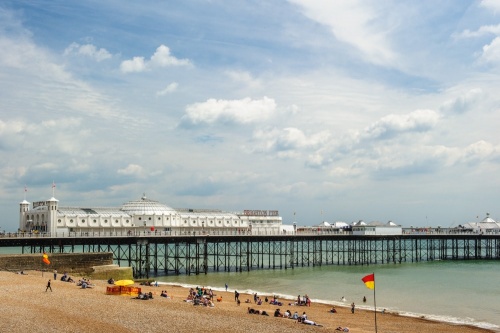
High Society flocked to Brighton in the royal wake, and Regency houses give many parts of the town an elegant air. Best of Regency Brighton is in ... wait for it ... Regency Square, where the terraced houses boast bow-windowed fronts and canopied iron balconies. Clifton Terrace is another lovely square built in the Regency style, though it actually dates from the 1850s!
Brighton has a history of entertainment Piers as well. The first was Chain Pier, built in 1823, but later destroyed by a storm. There are now 2 piers, West Pier (dating from 1866), and Palace Pier (1899). The Palace has gilded domes in imitation of the Brighton Pavilion. Close by is the Aquarium, now over 100 years old.
A few other of Brighton's attractions merit a mention. Dolls in Wonderland has over 300 historic dolls in its collection, dressed in authentic period costumes. The Booth Museum of Natural History is well known for its specialist exhibits of British birds in their natural surroundings.
There are remnants of old Brightelmstone left still - The Lanes follow the twisting course of medieval streets. In true medieval pattern, some of the houses project on the upper floors so that it is possible for people to shake hands across the width of the street. Many of these buildings are now antique shops.
About Brighton
Address: Brighton,
East Sussex,
England
Attraction Type: Town
Location map
OS: TQ315065
Photo Credit: David Ross and Britain Express
HERITAGE
 We've 'tagged' this attraction information to help you find related historic attractions and learn more about major time periods mentioned.
We've 'tagged' this attraction information to help you find related historic attractions and learn more about major time periods mentioned.
Find other attractions tagged with:
John Nash (Person) -
NEARBY HISTORIC ATTRACTIONS
Heritage Rated from 1- 5 (low to exceptional) on historic interest
Preston Manor - 0.7 miles (Historic House) ![]()
Brighton, St Peter's Church - 0.7 miles (Historic Church) ![]()
Royal Pavilion - 1.5 miles (Historic Building) ![]()
Brighton Fishing Museum - 1.6 miles (Museum) ![]()
The Regency Town House - 1.7 miles (Museum) ![]()
Hove, St Andrew's Church - 1.7 miles (Historic Church) ![]()
Stanmer Rural Museum - 2.3 miles (Museum) ![]()
Saddlescombe Farm - 4.1 miles (Countryside) ![]()
Nearest Holiday Cottages to Brighton:
Upper Beeding, West Sussex
Sleeps: 8
Stay from: £694 - 3767
Small Dole, West Sussex
Sleeps: 4
Stay from: £408 - 1957
More self catering near Brighton


